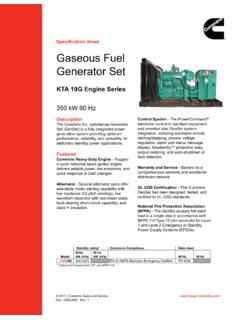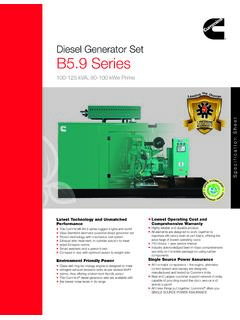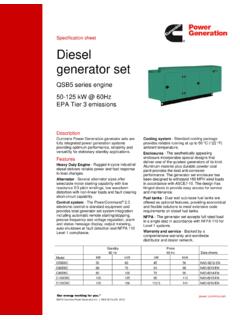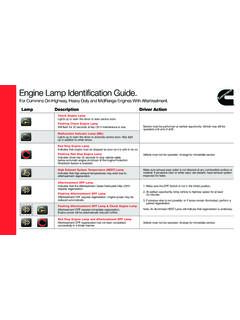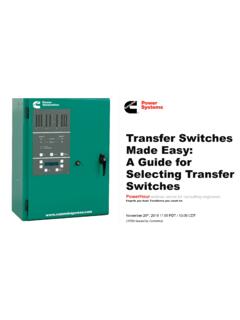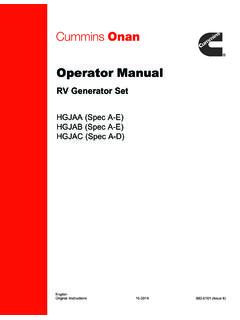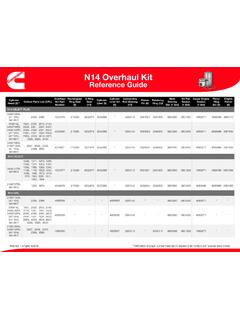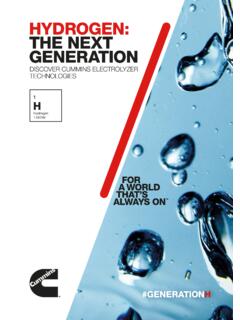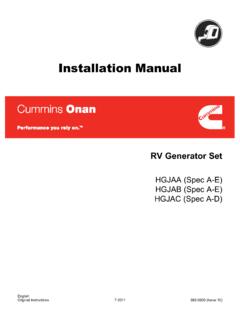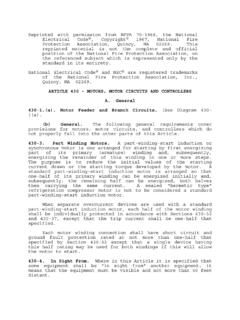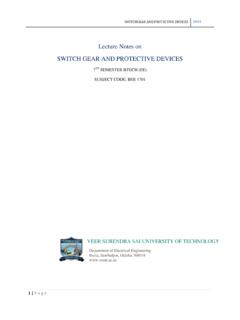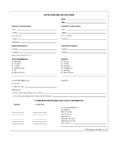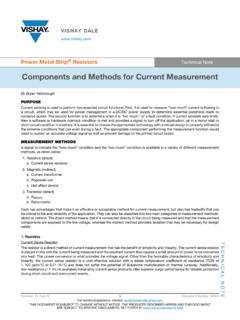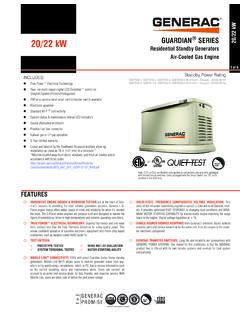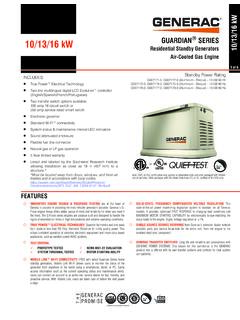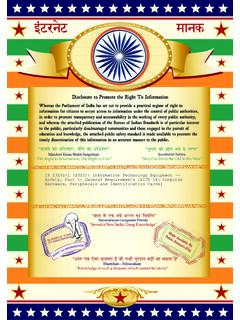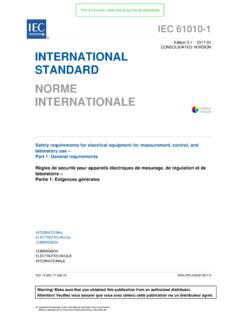Transcription of NEC 2017 Requirements for Generator Set Overcurrent …
1 PowerHourwebinar series for consulting engineersExperts you trust. Excellence you count 2017 Requirements for Generator Set Overcurrent ProtectionJanuary 24th, 2017 11:00 PDT / 13:00 CDT(1 PDH issued by Cummins)Welcome!PowerHour is designed to help our engineer partners Keep up to date on products, technology, and codes and standards development Interact with Cummins experts and gain access to ongoing technical support Participate at your convenience, live or on-demand Earn PDHT echnical tips: Audio is available through teleconference, or your computer (don t forget to unmute) You are in listen only mode throughout the event Use the WebEx Q&A Panelto submit questions, comments, and feedback throughout the event. We will provide sufficient Q&A time after presentation If you lose audio, get disconnected, or experience a poor connection, please disconnect and reconnect Report technical issues using the WebEx Q&A Panel, or email your panelists3 Munir KaderbhaiApplication EngineerCummins Power SystemsCummins presenter:Your local Cummins contacts: AZ, ID, NM, NV: Carl Knapp Rocky Mountain Region CO, MT, ND, UT, WY: Joe Pekarek Rocky Mountain Region IL, IA, NB, SD:John Kilinskis Central Region WI, MN, ND: Michael Munson Central Region MO, KS: Earnest Glaser Central Region TX:Scott Thomas Gulf Region FL, GA, SC, NC and Eastern TN: Robert Kelly South Region IN, KY, OH, TN, WV: Thomas Stadulis East Region NY, NJ, CT, PA, MD:Charles Attisani East Region For other states and territories, visit ScrogginsTechnical AdvisorCummins Power SystemsCummins facilitator.
2 Tom Bakritzes, Global Sales Training ManagerCummins PanelistCourse ObjectivesParticipants will be able to: Explain Generator excitation systems and their effect on fault current performance Identify basic Generator set Overcurrent protection Requirements in order to specify the correct protection equipment. Describe the NEC Requirements for selective coordination, Generator disconnect, arc flash energy reduction and separation of circuits in order to evaluate different means for achieving code compliance. Identify recent important codes changes to NFPA70 NEC 2017 pertaining to the topics listed above. 4 Agenda Generator performance under Overcurrent conditions Review of Generator excitation systems Alternator Decrement Curves PowerCommandAmpSentryfunctionality Describe NEC Requirements for Overload protection Selective coordination Arc Energy Reduction Generator disconnect Requirements Separation of circuits requirements5 Generator Excitation Systems Self (Shunt) ExcitedKey Point: AVR may not have the capability to support the fault current long enough to clear downstream faults as the main field in the alternator may Point.
3 Ability to provides sustained short circuit (SSC) current during fault conditions which prevent the field from collapsing and allows for faults downstream to clearGenerator Excitation Systems Separately Excited -PMG7 Alternator Performance Under a Fault -Decrement Curve (Separately Excited)I3ph, pu= (1/Xd -1/Xd )*e(-t/Td ) + (1/Xd -1/Xd)*e(-t/Td ) + 1/XdI3ph, pu= 1/Xd Current is a function of the AVR, Excitation System and alternator electro-magnetic design. Three phase fault characteristicsKey points: Alternator fault current decays, it doesn t remain constant like fault current from a transformer System design software tools such as SKM account for this8 Decrement Curve MultipliersInstantaneous Fault CurrentI3ph, 1/Xd ISLG, 3/( Xd + X2 + X0 + 3 Rf)ILL, (Xd + X2)Single phase faults result in higher levels of fault currentUnbalanced faults stress alternator rotor damper windingsSustained short circuit current is determined by the AVR and excitation systemIEEE Std142-2007 (Green Book) Unlike the transformer the three sequence reactancesfrom a Generator are not equal.
4 The zero sequence reactance has the lowest value and the positive sequence reactance varies as a function of time. Thus, a Generator will usually have a higher initial ground fault current than three phase fault current if the Generator has a solidly grounded neutral. 9 Per Unit Reactances Alternator reactancesare published using the alternator kVA rating as a base Fault current calculations need to use the same base or the reactancesneed to be converted to the genset kW rating base AmpSentry uses the genset standby kVA rating as a baseExample: Generator Set: 2500kW DQKAN, Alternator LVSI804X, 60Hz, 480 VGenerator Set kVA = 3125 Alternator kVA = 4464X dgenset= *3125 = Requirements Overload protection of Generator and conductors (Article and ) Selective coordination (Articles & & ) Arc Energy Reduction (Article ) Disconnecting Means for generators (Article ) Separation of Emergency Circuits (Article )11 Generator Overload protection Code Requirement (NFPA 70 (A)) generators , except AC Generator exciters, shall be protected from overloadsby inherent design, circuit breakers, fuses, protective relays or other identified Overcurrent protective means suitable for the conditions of : Where deemed.
5 Vital to the operation of the electrical overload sensing devices (shall) be permitted to be connected to an annunciator or Operation of equipment in excess of normal, full-load rating, or of a conductor in excess of rated ampacity that, when it persists for a sufficient length of time, would cause damage or dangerous overheating. A fault, such as a short circuit or ground fault, is not an overload. 12 Cable Overload protection NArticle (A): The ampacity of the conductors from the Generator terminals to the first distribution device(s) containing Overcurrent protection shall be not less than 115% of the nameplate current rating of the : Where the design and operation of the Generator prevent overloading, the ampacity of the conductors shall not be less than 100% of the nameplate current rating of the Generator . Article (G): Conductors from Generator terminals that meet shall be permitted to be protected by the Generator overload protective device(s) required by (B) generators .
6 Ampacity of Conductors. Overcurrent protection Provided Where the Generator set is equipped with a listed Overcurrent protective device or a combination of a current transformer and Overcurrent relay, conductors shall be permitted to be tapped from the load side of the protected terminals in accordance to (B)14 Generator Set Overload protection (A)ConductorSize /Overload protection (A), (G) Taps on main generatorset feeder conductor (B) (TIMES RATED)TIME (SECONDS) Generator THERMAL DAMAGECURVE100 CABLE THERMAL DAMAGE CURVEIs the protection There? Generator and cable is required to be protected Thermal damage isn t total failure Conventional wisdom is not correct Most common protection is molded case breaker(s) with thermal/magnetic trip Fully rated breakers don t protect Generator Need fully adjustable electronic trip on the MCCB or other listed protective device Any breaker used is susceptible to some level of nuisance trips due to instantaneous functionCABLE THERMAL DAMAGE CURVE16 Inherently Designed Overcurrent protection -AmpSentry Protective Relay Overcurrent protection integral to the Cummins PowerCommandControl System UL listed device Provides Overcurrent protection by shutting down the genset before alternator thermal damage occurs If current exceeds 300% of rated, AmpSentry decreases excitation to regulate current at 300% until: Fault is cleared by a downstream breaker Or Generator set is shut down based on.
7 Thermal damage curve for 3 phase fault 2 seconds for L-G fault 5 seconds for L-L fault17 AmpSentry Trip Curve Library Files available in: SKM POWER*TOOLS EasyPower SuitesLink to access the trip curve - Phase L1-L2-L3 Short: AmpSentry Regulation and Shutdown05010015020025030035040045050005 101520tim e, sec%CurrentAlt %Standby Max LineCurrent3-Phase Fault Response with AmpSentry Overcurrent RelayPeak Current: IR/X dRegulates at 3X RatedShuts down before damage193 Phase L1-L2-L3 Short and Re cov e ry: L-N Voltage s v s. Time0204060801001200246810tim e, secPercent of Nominal VoltageAlt L1-N Voltage (%)Alt L2-N Voltage (%)Alt L3-N Voltage (%)Voltage Recovery (3-phase fault) with AmpSentry Overcurrent Relay20 AmpSentryand Neutral Grounding Resistors Neutral Grounding Resistors are not required to protect Generator sets that are equipped with the AmpSentryprotective relay NGR s may still be necessary as part of the overall grounding and protection scheme AmpSentrywill not limit instantaneous ground fault current In the event of a L-G fault AmpSentrywill regulate current in the faulted phase at 300% of rated current for 2 seconds at which time the Generator set will shut down (or until some protective device clears the fault)21 Online Certification AmpSentryis UL Listed as a protective Label23 What is Selective Coordination?
8 NEC Article 100 Definition Selective Coordination: Localization of an over-current condition to restrict outages to the circuit or equipment affected, accomplished by the choice of over-current protective devices and their ratings or settings Selective Coordination is required for emergency, legally required standby and critical operations power systems circuits NEC , , and ..power system(s) shall be selectively coordinated with all supply side OCPDs. over-current24 Selective CoordinationWithout Selective CoordinationOPENSNOT AFFECTEDUNNECESSARYPOWER LOSSF aultOPENSNOT AFFECTEDWith Selective CoordinationFault25 Demonstrating Selective Coordination Engineers will use software packages such as SKM to demonstrate coordination on their projects AmpSentryis included in the latest version of SKM and EasyPowerTrip curves overlap these breakers are not coordinated for high levels of fault currentNo overlap -breakers are coordinated in this region of the curve26 Overlap Exception Circuit breaker manufacturers can demonstrate coordination with their own products Published coordination charts Drives project to use consistent devices through the entire projectPOTENTIALPROBLEMAREA27 AmpSentryand Selective Coordination Amp Sentry simplifies coordination by regulating fault current until the downstream breaker clears Genset mounted molded case circuit breaker present challenges in coordinating with downstream
9 Breakers The inclusion of AmpSentry in SKM and EasyPowersoftware simplifies design of coordinated systems28(N) NFPA 70 (B) Arc Energy Reduction Where the highest continuous current trip setting is 1200A or higher .. one of the following or approved equivalent means (to reduce clearing time) shall be Energy-reducing maintenance switching with local status an energy reducing maintenance switch allows a worker to set a circuit breaker trip time to no intentional delay 29 Generator Set Circuit Breaker Arc Flash protection Example Square D P and H Micrologic solid state trip units (P and H) Energy Reduction Maintenance Setting (ERMS)ERMS Switch OFF and ON ModeERMS Label on TripUnitLocal ERMS Switch30 Generator Set Integrated Arc Flash protection AmpSentry Maintenance Mode AmpSentryMaintenance Mode similar to circuit breaker arc energy reducing function Instantaneous Generator set shutdown in the event of a short circuit, bypassing all time delays Can also be configured to shunt trip a downstream breaker Enabled by a customer input or by connecting InPowerservice tool Complies with NEC requirement for arc energy reduction31 AmpSentryand NEC Arc Flash Reduction Arc energycalculation depends on several site specific factors Available fault current, arc interrupting time, system voltage, grounding method, conductor gap, working distance Maintenance Mode reduces arc interrupting time Shuts down gensetwithin 50 msec Configurable output can shunt trip a breaker32 Generator Set Disconnect Means and Shutdown of Prime Mover (N) NFPA 70-2014, (A)
10 Disconnecting Means - generators shall be equipped with disconnect(s), lockable in the open position (B) Shutdown of Prime Mover (1) Provisions to disable all prime mover start control circuits (2) Initiate a shutdown mechanism that requires a mechanical reset Provisions for (B) permitted to satisfy Requirements for (A) if capable of being locked out. (C) Generator Installed in Parallel Provisions of (A) shall be capable of isolation the Generator output terminals from the paralleling equipment. Disconnect means shall not be required to located at the Set Disconnect Means and Shutdown of Prime Mover (cont.)E-stop switch with lockable shroudDisconnect starter battery and lockout34 Lock Out Tag Out NFPA 70E Requires that equipment must be disconnected from all sources of electrical supply Neither the E-stop switch or a gensetmounted breaker is sufficient to meet LOTO Requirements Gensethas two sources of electrical supply Battery + charging system Utility or paralleled genset LOTO procedure should include Removing and locking out battery cable Locking out breaker that feeds charging system Locking out paralleling breaker that connects utility or paralleled genset35 Separation of Emergency CircuitsNFPA70-2014 (B)(5)(c).
